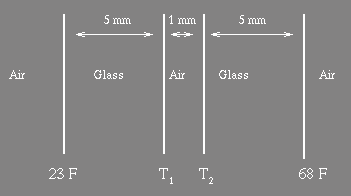
(b) The thermal conductivity of air is 40 times smaller than that of glass. The window pane is
replaced by a double-glazed pane having a 1 mm air gap, indicated below. What are the
temperatures of the inner faces of the glass (T1, T2) ? (10)
3) A
single
pane of glass 1 cm thick, 50 cm wide and 100 cm long, loses heat from
the
inside
of
a house at a rate of 1.25 kW, when the inside of the house is
maintained
at 68F and the
outside
temperature is 23F.
(a) Calculate the thermal conductivity of the glass (5)

(b) The thermal conductivity
of air is 40 times smaller than that of glass. The window pane is
replaced
by a double-glazed pane having a 1 mm air gap, indicated below. What
are
the
temperatures
of the inner faces of the glass (T1, T2) ?
(10)

In steady state heat flow through each glass pane and the air gap must be equal, thus,

(c) Determine the rate
of heat loss through this, double-glazed, window.
(6)

(d) In practice a double-glazed
window is never able to achieve the reduction in heat loss
determined
from (a) to (c) above. Can you explain why this is the case ?
(4)
Air in the gap is not stagnant. Convection
currents
will be set up which will add to the
conduction
heat transfer.